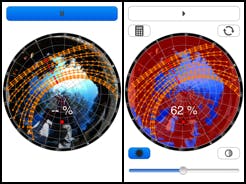Smartphone apps help photovoltaics installers site their modules for best sun
Arezzo, Italy--Luca Polverini, a software developer, is creating apps for smartphones to help photovoltaic (PV)-module installers position modules for maximum productivity. His first app, SunFinder, requires only an iPhone or Android phone and instantly calculates how much sunlight will shine on a module and how much electricity it will produce in a year. His next app, still in beta testing, combines an iPhone 4 with a convex mirror to do in-situ shading analysis of a PV-module site.
SunFinder
This free app, which can be found now on iTunes and the Android Market, is being publicized through Dunmore (Bristol, PA), a company that makes coated, laminated, and metallized films. With the app, a user simply positions a smartphone as if it were a module, tilting it to find the optimal angle. SunFinder then displays the estimated amount of sunlight that strikes the site in a year and how much electricity it will produce.
"It's the solar-module equivalent of a stud finder," said Michael Sullivan of Dunmore. (Dunmore is primarily interested in boosting PV efficiency through optimizing its films, and feels SunFinder can be of use to its customers, who include PV installers.)
Based on GPS coordinates, SunFinder finds the azimuth angle (referenced to the south) and the tilt angle of the installation and performs its calculations, extracting data from a solar-radiation database. SunFinder also provides the user with weather profiles for 240 specific locations in the USA and 100 in Italy. The app also automatically compiles data (position coordinates, azimuth, tilt, reference data points, yearly solar radiation, and yearly average PV production) into an email for easy distribution.
Shading-analysis app
Polverini's newer app provides a quick but thorough shading analysis for any PV-module site. Along with the required iPhone 4 software, Polverini provides a convex mirror, which is set on the ground with the convex side facing up. The iPhone's camera is pointed straight down at the mirror; the software captures a 360° horizontal and 180° vertical panorama and overlays the sun's path for all times of year based on GPS data (see figure).
The operator then presses a calculation button, triggering the app to evaluate where is the unobstructed sky is in the image (blue layer) and where are obstacles (red layer), and calculates the shading factor. Using a slider and the button, the operator can review the calculations and refine the results. The operator can also remove the "sky/non-sky" layer and use the touchscreen to paint portions of the image for analyzing the shading impact of a single object or group of objects (a tree for example).
Polverini is very near commercialization and is looking for ten beta testers anywhere in the world. Anyone who qualifies and who has an iPhone 4 can pay 150 Euro to Polverini to obtain the mirror and the software. Beta testers also receive free software updates.
For more info, email Polverini at: [email protected]
Also see: www.nrg-project.it/sunfinder/

John Wallace | Senior Technical Editor (1998-2022)
John Wallace was with Laser Focus World for nearly 25 years, retiring in late June 2022. He obtained a bachelor's degree in mechanical engineering and physics at Rutgers University and a master's in optical engineering at the University of Rochester. Before becoming an editor, John worked as an engineer at RCA, Exxon, Eastman Kodak, and GCA Corporation.
